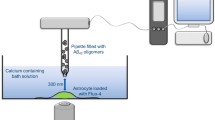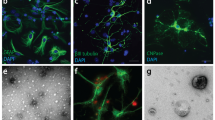Summary
Distinct aggregates of small intramembranous particles and assemblies characterize the P-face of freeze-fractured astrocytic membranes. To test the lability of the assemblies, astrocytes were treatedin vitro with different chemical agents andin vivo by cold injury. The assemblies appeared either to contain or be associated with protein because exposure to medium containing cycloheximide, an inhibitor of protein synthesis, led to a sharp decrease in assemblies, down to 1% of the control levels within three hours. To ascertain whether the assemblies were tethered to the cytoskeleton, the cells were treatedin vitro with disruptors of microtubules (colchicine) or microfilaments (cytochalasins); the assemblies became consistently rearranged. Protein denaturants, urea and guanidine HC1, brought about a selective aggregation of assembly with assembly. The lectin, concanavalin A, did not alter the distribution of the assemblies within the plane of the membrane fracture. Surface replicas ofin vitro, non-fractured, astrocytes revealed surface particles which did not resemble assemblies.In vivo, the plasma membranes of astrocytes were altered within minutes of cold injury to the brain surface. In the centre of the lesions, damaged astrocytes had assemblies that were clumped luce those ofin vitro astrocytes exposed to denaturants. In the periphery of the lesions, however, the assemblies did not aggregate but increased in number.
These results provide indirect evidence that assemblies may consist of protein, that the recognizable particle constituent of the assembly is confined to the interior of the membrane and is not present on the uncleaved cell surface, and that assemblies are connected with the cytoskeleton. Therefore, certain changes in the environment of the astrocyte caused by injuryin vivo or addition of chemical agentsin vitro alter the distribution of assemblies in the astrocytic plasma membrane either by a direct effect on the assemblies or indirectly by an alteration of the cytoplasmic proteins.
Similar content being viewed by others
References
Allison, A. C. (1973) The role of microfilaments and microtubules in cell movement, endocytosis and phagocytosis.Ciba Foundation Symposium 14, 109–48.
Anders, J. J. &Brightman, M. W. (1979a) Assemblies of particles in the cell membranes of developing, mature and reactive astrocytes.Journal of Neurocytology 8, 777–95.
Anders, J. J. &Brightman, M. W. (1979b) Freeze-fractured appearance of denatured intramembranous proteins.Journal of Cell Biology 82, 279a (abstract).
Anders, J. J. &Brightman, M. W. (1980) Alterations of astrocytic intramembranous particles after exposure to cycloheximide or colchicine.European Journal of Cell Biology 22, 213 (abstract).
Anders, J. J. &Brightman, M. W. (1981a) Initial changes in astrocytic membranes at the site of injury to the central nervous system.Anatomical Record 199, 9A (abstract).
Anders, J. J. &Brightman, M. W. (1981b) Orthogonal assemblies of intramembranous particles-an attribute of the astrocyte. InEleventh International Congress of Anatomy, Part A: Glial and Neuronal Cell Biology. Progress in Clinical and Biological Research (edited byFederoff, S.), pp. 21–35. New York: Alan R. Liss, Inc.
Anders, J. J. &Brightman, M. W. (1981c) Alterations of astrocytic plasma membranes after exposure to high CO2 in vitro.Society for Neuroscience Abstracts 7, 423.
Anders, J. J. &Pagnanelli, D. M. (1979) The protein nature and arrangement of intramembranous particles assemblies in normal and reactive astrocytes.Anatomical Record 193, 470 (abstract).
Anderson, T. F. (1951) Techniques for the preservation of three-dimensional structure in preparing specimens for the electron microscope.Transactions of the New York Academy of Science 13, 130–34.
Bordi, C. &Perrelet, A. (1978) Orthogonal arrays of particles in plasma membranes of the gastric parietal cell.Anatomical Record 192, 297–304.
Branton, D. (1971) Freeze-etching studies of membrane structure.Philosophical Transactions of the Royal Society of London Series B 261, 133–8.
Cervos-Navarro, J. &Ferszt, R. (editors) (1981)Brain Edema Pathology, Diagnoses and Therapy. Advances in Neurology. Vol. 28, pp. 1–511. New York: Raven Press.
Clasen, R. A., Cooke, P. M., Pandolfi, S., Boyd, D. &Raimondi, A. J. (1962) Experimental cerebral edema produced by focal freezing. 1. An anatomic study utilizing vital dye techniques.Journal of Neuropathology and Experimental Neurology 21, 570–95.
Copeland, M. (1974) The cellular response to cytochalasin B: A critical overview.Cytologia 39, 709–27.
Dekruijff, B., Verkley, A. J., Van Echteld, C. J. A., Gerritsen, W. J., Mombers, C., Noordam, P. C. &Degier, J. (1979) The occurrence of lipidic particles in lipid bilayers as seen by31PNMR and freeze-fracture electron microscopy.Biochimica et Biophysica Acta 555, 200–9.
Dermietzel, R. (1974) Junctions in the central nervous system of the cat. III. Gap junctions and membrane-associated orthogonal particle complexes (MOPC) in astrocytic membranes.Cell and Tissue Research 149, 121–35.
Edwards, H. H., Mueller, T. J. &Morrison, M. (1979) Distribution of transmembrane polypeptides in freeze-fracture.Science 203, 1343–6.
Elfvin, L. G. &Forsman, C. (1978) The ultrastructure of junctions between satellite cells in mammalian sympathetic ganglia as revealed by freeze-etching.Journal of Ultrastructure Research 63, 261–74.
Ellisman, M., Brooke, M. H., Kaiser, K. K. &Rash, J. E. (1978) Appearance in slow muscle sarcolemma of specializations characteristic of fast muscle after reinnervation by a fast muscle nerve.Experimental Neurology 58, 59–67.
Eng, L. F. &Bigbee, J. W. (1978) Immunohistochemistry of nervous system-specific antigens. InAdvances in Neurochemistry Vol. 3, (edited byAgranoff, B. W. &Aprison, M. H.), pp. 43–98. New York: Plenum Publishing Corp.
Fowler, V. M., Luna, E. J., Hargreaves, W. R., Lansing-Taylor, D. &Branton, D. (1981) Spectrin promotes the association of F-actin with the cytoplasmic surface of the human erythrocyte membrane.Journal of Cell Biology 88, 388–95.
Fox, J. E. B. &Phillips, D. R. (1981) Inhibition of actin polymerization in blood platelets by cytochalasins.Nature 292, 650–2.
Gilbert, D. (1978) 100 nm filaments.Nature 272, 577–8.
Groschel-Stewart, U., Unsicker, K. &Leonhardt, H. (1979) Immunohistochemical demonstration of contractile proteins in astrocytes, marginal glial and ependymal cells in rat diencephalon.Cell and Tissue Research 180, 133–7.
Hass, G. M. &Taylor, C. B. (1953) Quantitative studies of experimental production and treatment of acute closed cerebral injury.Archives of Neurological Psychiatry 69, 145–70.
Hatton, J. D. &Ellisman, M. H. (1981) The distribution of orthogonal arrays and their relationship to intercellular junctions in neuroglia of the freeze-fractured hypothalamo-neurohypophysial system.Cell and Tissue Rsearch 215, 309–323.
Hogan, J. C. &Manuelidis, L. (1976) Intramembrane particle distribution and lectin binding of glioblastoma cells after long term subculture.Acta Neuropathologica 36, 199–208.
Humbert, F., Pricam, C., Perrelet, A. &Orci, L. (1975) Specific plasma membranedifferentiations in the cells of the kidney collecting tubule.Journal of Ultrastructure Research 52, 13–20.
Inoue, S. &Hogg, J. C. (1977) Freeze-etch study of the tracheal epithelium of normal guinea pigs with particular reference to intercellular junctions.Journal of Ultrastructure Reseach 61, 89–99.
Kreutziger, G. O. (1968) Freeze-etching of intercellular junctions of mouse liver. InProceedings of the 26th Meeting of the Electron microscope Society of America, p. 234. Baton Rouge: Claitors Publishing Division.
Landis, D. M. D. &Reese, T. S. (1974) Arrays of particles in freeze-fractured astrocytic membranes.Journal of Cell Biology 60, 316–20.
Landis, D. M. D. &Reese, T. S. (1981) Astrocyte membrane structure: Changes after circulatory arrest.Journal of Cell Biology 88, 660–3.
Landis, D. M. D., Reese, T. S., Ornberg, R. L. &Graham, W. F. (1981) Substructure in astrocytic assemblies demonstrated by rapid freezing and low-temperature freeze-fracture.Society for Neuroscience Abstracts 7, 305.
Luna, E. J., Fowler, V. M., Swanson, J., Branton, D. &Lansing-Taylor, D. (1981) A membrane cytoskeleton fromDictyostelium discoideum 1. Identification and partial characterization of an actin-binding activity.Journal of Cell Biology 88, 396–409.
Massa, P. T. &Mugnaini, E. (1982) Cell junctions and intramembrane particles of astrocytes and oligodendrocytes: A freeze-fracture study.Neuroscience 7, 523–38.
Meyer, H. W. &Winkelman, H. (1970) Nachweis der Membranspaltung bei der Gefrieratzpreparation an Erythrozytenghosts und die Beeinflussung der Membranestruktur durch Hanstoff.Protoplasm 70, 233–46.
Moore, P. B., Ownby, C. L. &Carraway, K. L. (1978) Interactions of cytoskeletal elements with the plasma membrane of sarcoma 180 ascites tumour cells.Experimental Cell Research 155, 331–42.
Nabeshima, S., Reese, T. S., Landis, D. M. D. &Brightman, M. W. (1975) Junctions in the meninges and marginal glia.Journal of Comparative Neurology 164, 127–70.
Nakai, Y., Kudo, J. &Hashimoto, A. (1980) Specific cell membrane differentiation in the tanycytes and glial cells of the Organum Vasculosum of the Lamina Terminalis in dog.Journal of Electron Microscopy 29, 144–50.
Necas, O. &Svoboda, A. (1973) Effect of urea on the plasma membrane particles in yeast cells and protoplasts.Protoplasma 77, 453–66.
Pannese, E., Luciano, L., Iurato, S. &Reale, E. (1977) Intercellular junctions and other membrane specializations in developing spinal ganglia: A freeze-fracture study.Journal of Ultrastructure Research 60, 169–80.
Peters, A., Palay, S. L. &Webster, H. de F. (1976)The Fine Structure of the Nervous System, pp. 233–48. Philadelphia: W. B. Saunders Company.
Pinto Da Silva, P., Parkison, C. &Dwyer, N. (1981) Fracture-label: cytochemistry of freeze-fracture faces in the erythrocyte membrane.Proceedings of the National Academy of Science USA 78, 343–7.
Pollard, T. D. &Korn, E. D. (1973) Electron microscopic identification of actin associated with isolated amoeba plasma membranes.Journal of Biological Chemistry 248, 448–50.
Prescott, L. &Brightman, M. W. (1978) A technique for the freeze-fracture of tissue culture.Journal of Cell Science 301, 34–43.
Rapoport, S. (1976)Blood Brain Barrier in Physiology and Medicine. New York: Raven Press.
Rash, J. W., Staehelin, L. A. &Ellisman, M. H. (1974) Rectangular arrays of particulars on freeze-cleaved plasma membranes are not gap junctions.Experimental Cell Research 86, 187–90.
Reale, E. &Luciano, L. (1974) Introduction to freeze-fracture method in retinal research.Albrecht Von Graefes Archiv für Klinische und Experimentelle Opthalmologie 192, 73–87.
Schmalbruch, H. (1979) ‘Square arrays’ in the sarcolemma of human skeletal muscle fibres.Nature 281, 145–6.
Schmechel, D. E., Brightman, M. W. &Barker, J. L. (1980) Localization of neuron-specific enolase in mouse spinal neurons grown in tissue culture.Brain Research 181, 391–400.
Sotelo, J. B., Tok, H., Lolait, S. J., Yildiz, A., Osung, O. &Holborow, E. J. (1980) Cytoplasmic intermediate filaments in cultured glial cells.Neuropathology and Applied Neurobiology 6, 291–8.
Spray, D. C., Harris, A. L. &Bennett, M. V. L. (1981) Gap junctional conductance is a simple and sensitive function of intracellular pH.Science 211, 712–5.
Staehelin, L. A. (1972) Three types of gap junctions interconnecting intestinal epithelial cells visualized by freeze-etching.Proceedings of the National Academy of Science USA 69, 1318–21.
Thorn, W., School, H., Pfleiderer, G. &Mueldener, B. (1958) Metabolic processes in the brain at normal and reduced temperatures and under anoxic and ischemic conditions.Journal of Neurochemistry 2, 150–65.
Tsukita, S., Ishikawa, H. &Kurokawa, M. (1981) Isolation of 10-nm filaments from astrocytes in the mouse optic nerve.Journal of Cell Biology 88, 245–50.
Tourtellotte, M. E. &Zupnik, J. S. (1973) Freeze-fracturedAcholeplasma Malawi membranes: nature of particles observed.Science 179, 84–6.
Verkleij, A. J., Mombers, C., Gerritsen, W. J., Leuissen-Bijvelt, L. &Cullis, P. R. (1979) Fusion of phospholipid vesicles in association with the appearance of lipidic particles as visualized by freeze fracturing.Biochimica et Biophysica Acta 555, 358–61.
Wang, E., Cross, R. K. &Choppin, W. (1979) Involvement of microtubules and 10-nm filaments in the movement and positioning of nuclei in syncytia.Journal of Cell Biology 83, 320–37.
Weihing, R. R. (1979) The cytoskeleton and plasma membrane. InMethods and Achievements in Experimental Pathology Vol. 8 (edited byJasmin, G. &Cantin, M.), pp. 42–109. Basel: S. Karger.
Wells, V. &Mallucci, L. (1978) Determination of cell form in cultured fibroblasts-role of surface components and cytokinetic elements.Experimental Cell Research 116, 301–12.
Yen, S. H. &Fields, K. L. (1981) Antibodies to neurofilament, glial filament and fibroblast intermediate filament proteins bind to different cell types of the nervous system.Journal of Cell Biology 88, 115–26.
Author information
Authors and Affiliations
Rights and permissions
About this article
Cite this article
Anders, J.J., Brightman, M.W. Particle assemblies in astrocytic plasma membranes are rearranged by various agentsin vitro and cold injuryin vivo . J Neurocytol 11, 1009–1029 (1982). https://doi.org/10.1007/BF01148314
Received:
Revised:
Accepted:
Issue Date:
DOI: https://doi.org/10.1007/BF01148314




